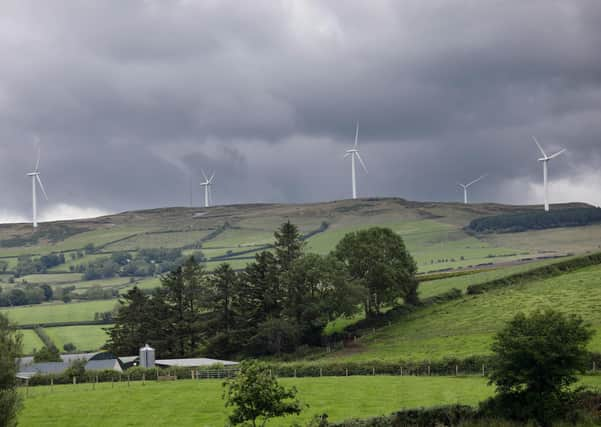NI land-based sector can play central role in future energy strategy


The consultation also set out a 70 percent renewable electricity target by 2030.
Currently, this is sitting at 47 percent, to which many of our members have contributed significantly with the land-based sector in NI producing enough renewable energy generated by the land-based sector to provide power to 150,000 homes.
Advertisement
Advertisement
Farming is very much in the line of fire in relation to the climate change debate, yet we have the resources and expertise at hand to play a role in carbon emission reduction through small scale renewables, through both existing and future generation. When it comes to minimising on-farm carbon emissions, embracing small scale renewable energy is an ideal option for many. A modest 50 kWp solar array (can be located on the roof for poultry units/milking parlours etc.) has the potential to save 13,500kg of C02 every year. Even a small on-farm array can save 1,200 kg of carbon a year.
The problem is this that these savings are not considered under current carbon accounting data. On-farm renewables fall into the energy inventory, the same way on-farm tree planting goes into ‘Land Use, Land Use Change and Forestry’ (LULUCF). Hence, the Ulster Farmers’ Union (UFU) are calling for the carbon savings emulating from on-farm renewable technologies to be reflected in the agriculture figures. The use of integrated on-farm renewables will reduce the emissions attributed to our sector and this should be accounted for accordingly.
In relation to the role to be played by the land-based sector in this consultation, the UFU called for focus to be on the following areas, in no discernible order; distributed generation; biogas production (focus on biomethane); battery storage; behind the metre technology; micro grids; peer-to-peer trading and the better/more efficient utilisation of existing renewable installations.
Distributed generation
Distributed generation (also known as embedded, on-site, dispersed or decentralised generation) could deliver the criteria set out by DfE and needs to be considered in the context of energy strategy in NI. Generation includes solar PV, small wind turbines, AD, hydro technologies and is complimentary to the set-up of the vast majority of farm structures in NI.
One-stop shop
Advertisement
Advertisement
One proposal in the consultation concerns the setting up of a one-stop-shop for consumers similar to nibusinessinfo.co.uk. The UFU are calling for the establishment of an overarching body to deal specifically with energy, for both domestic and non-domestic customers and specifically prosumers, we must avoid the creation of a toothless ‘talking shop’. Instead, this body needs to be made up of officials who have a practical understanding of energy in NI and crucially, there is an urgent need for the establishment of an energy/grid commissioner to oversee this body.
Future support for small scale renewables
The consultation proposes a Contract for Difference (CfD) scheme similar to Great Britain (GB), but the UFU would be concerned as to limiting the accessibility to higher levels of capacity. In GB, CfD relates to 5MW and above, consequently, consideration must be given to small scale renewables in terms of capacity. The UFU are calling for ring-fencing of support for this level of generation, within CfD if the capacity levels are lowered.
Biomethane
In our response we set our support for the much-needed legislative and regulatory steps to facilitate biomethane injection into the gas network. Biomethane provides further green credentials to the gas network by displacing levels of natural gas, in fact 30 percent of natural gas could be displaced by Biomethane. NI’s substantial rural agriculture base can support the growth of the biogas sector as the primary providers of biomethane. DAERA in their 2019 report on reducing emissions in NI, took a positive view on biomethane production stating that NI could produce 130-580 million m3 of biomethane per year to generate up to 2,000 GWh of power or heat annually.
This is in addition to the benefits to our sector of biomethane for transport and of course, the role for the production of ‘green hydrogen’.
Caution
Advertisement
Advertisement
Only this month, the government’s independent advisory committee on climate change issued their report “Independent Assessment of UK Climate Risk”. They stressed the need that the distribution (electricity) grid can withstand extreme weather. Energy transition will see the increased demand for electricity as people switch to EVs and heat pumps. In the UK, electricity currently accounts for 15-20 percent of energy use, and this is likely to rise to 65 percent. Extreme weather therefore could lead to system failures and blackouts according to the committee. This could be countered with the long-awaited and much needed strengthening of the 1,600 miles of low voltage 11kV lines which crosses NI. A more cost-effective option compared to the massive costs linked to many infrastructure projects needed.
And then there’s the cost.
An internal UK government impact assessment has calculated that the cost could be as much as £651 billion to meet net zero targets and rising. Whilst the debate is carrying on in terms of the affordability of electric cars etc, government economists seem to have overlooked the impact on inflation of the drive towards net zero and energy transition.
Conclusion
Our message is that despite the challenges of cost and the fact that the necessary infrastructure is not yet in place. There was an affordable option available through distributed generation, with biomethane playing a significant role in the meeting aspiration towards net zero carbon, but this must be supported by both joined-up government and an overhaul of the role of the utility regulator.